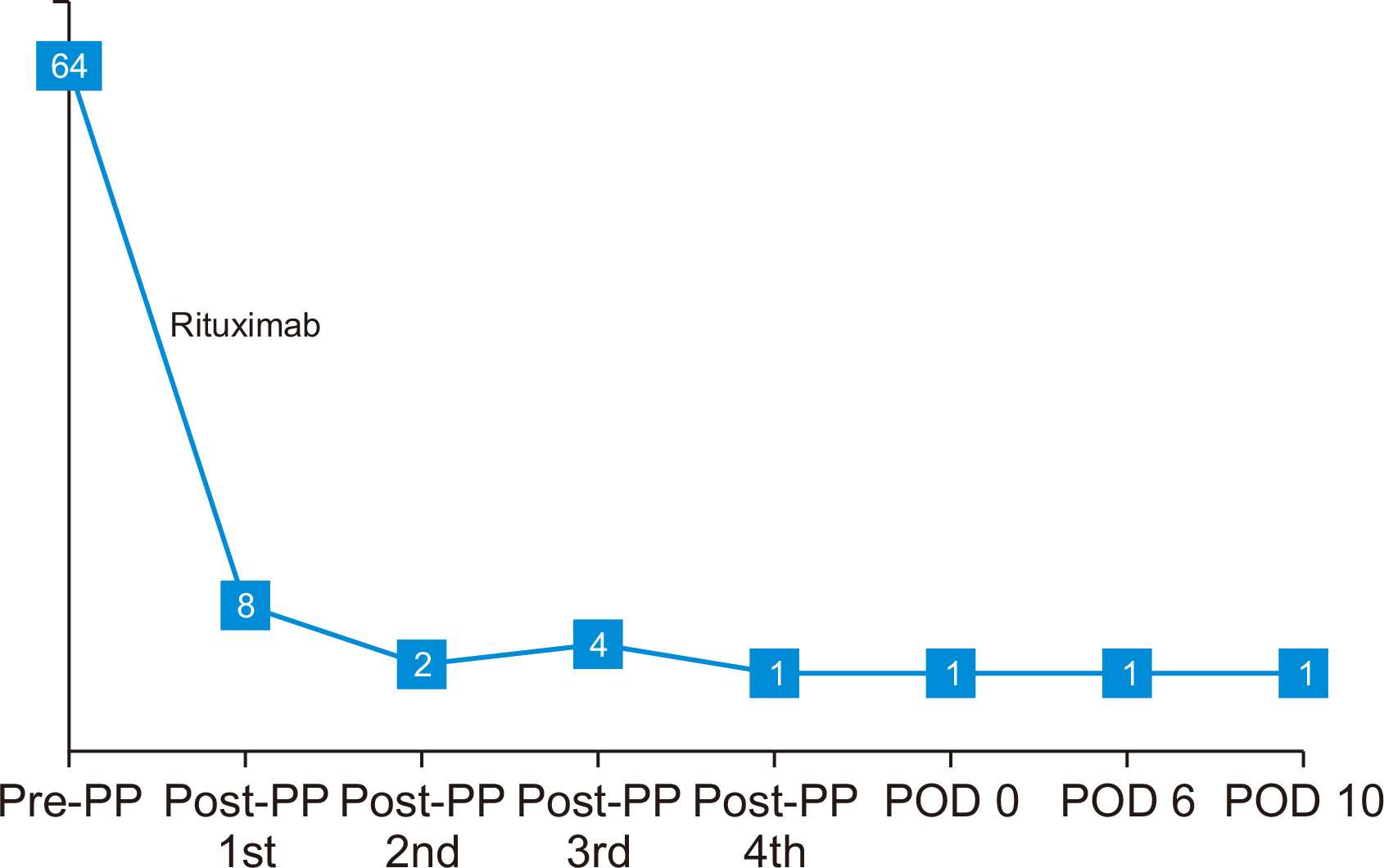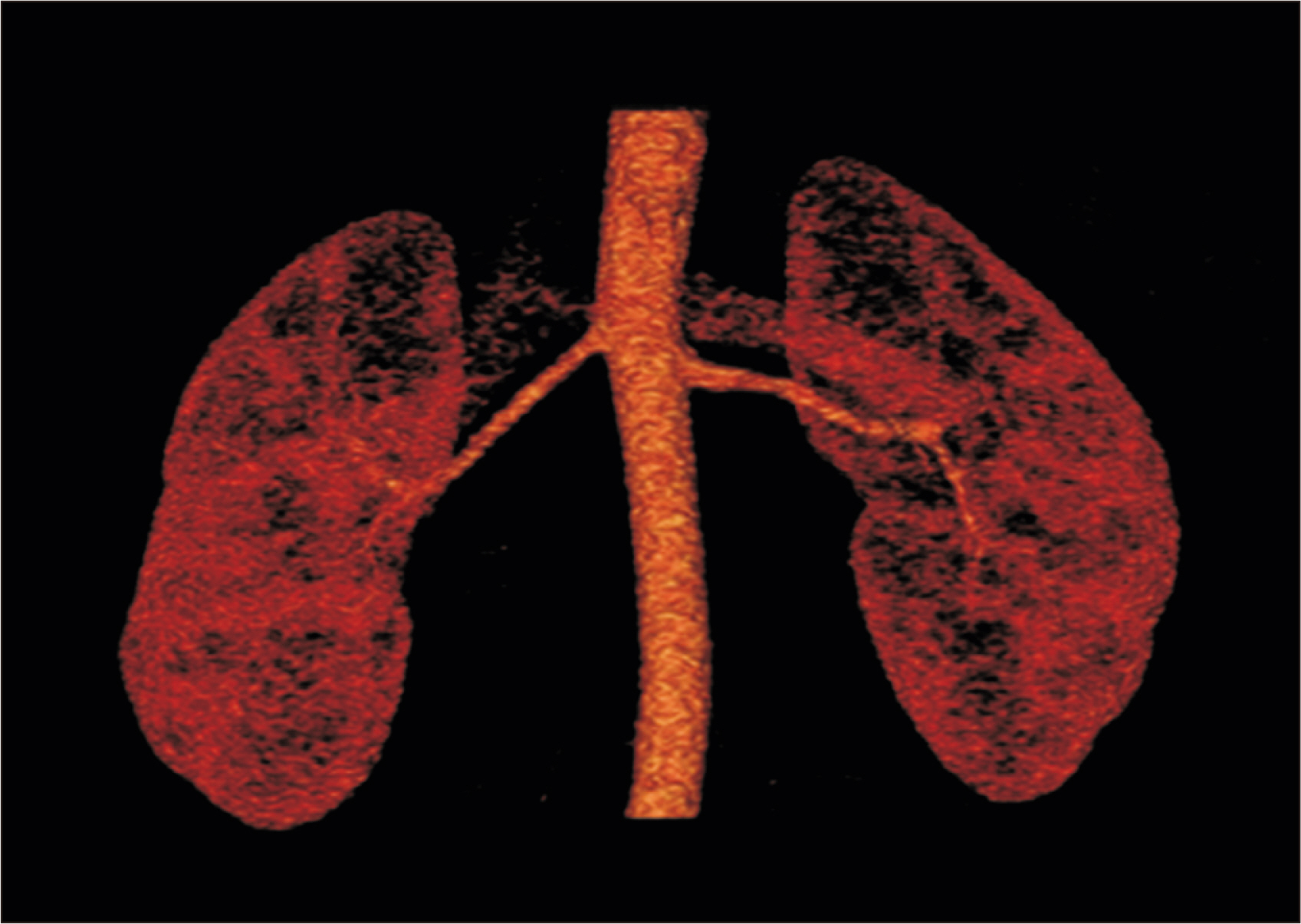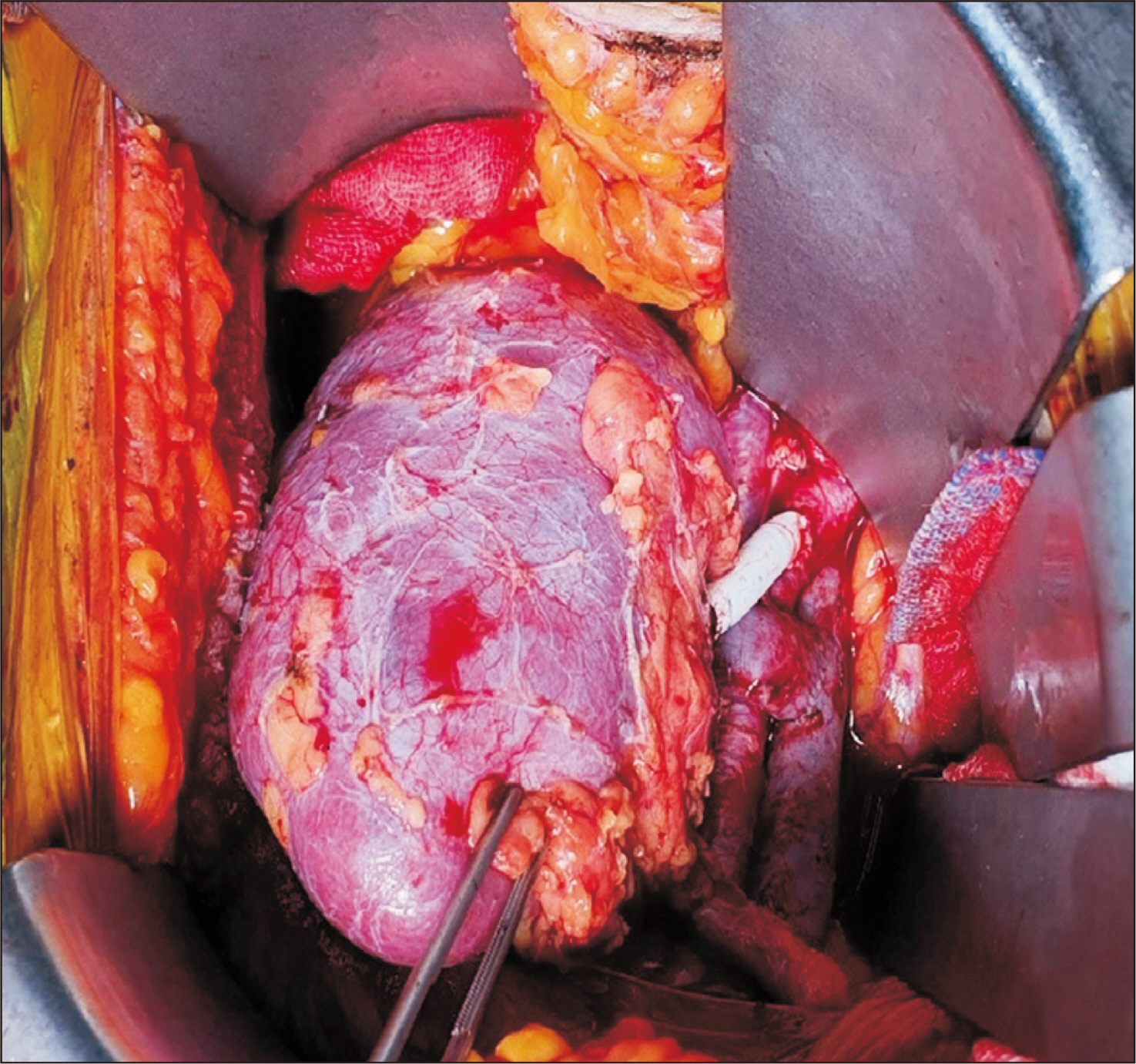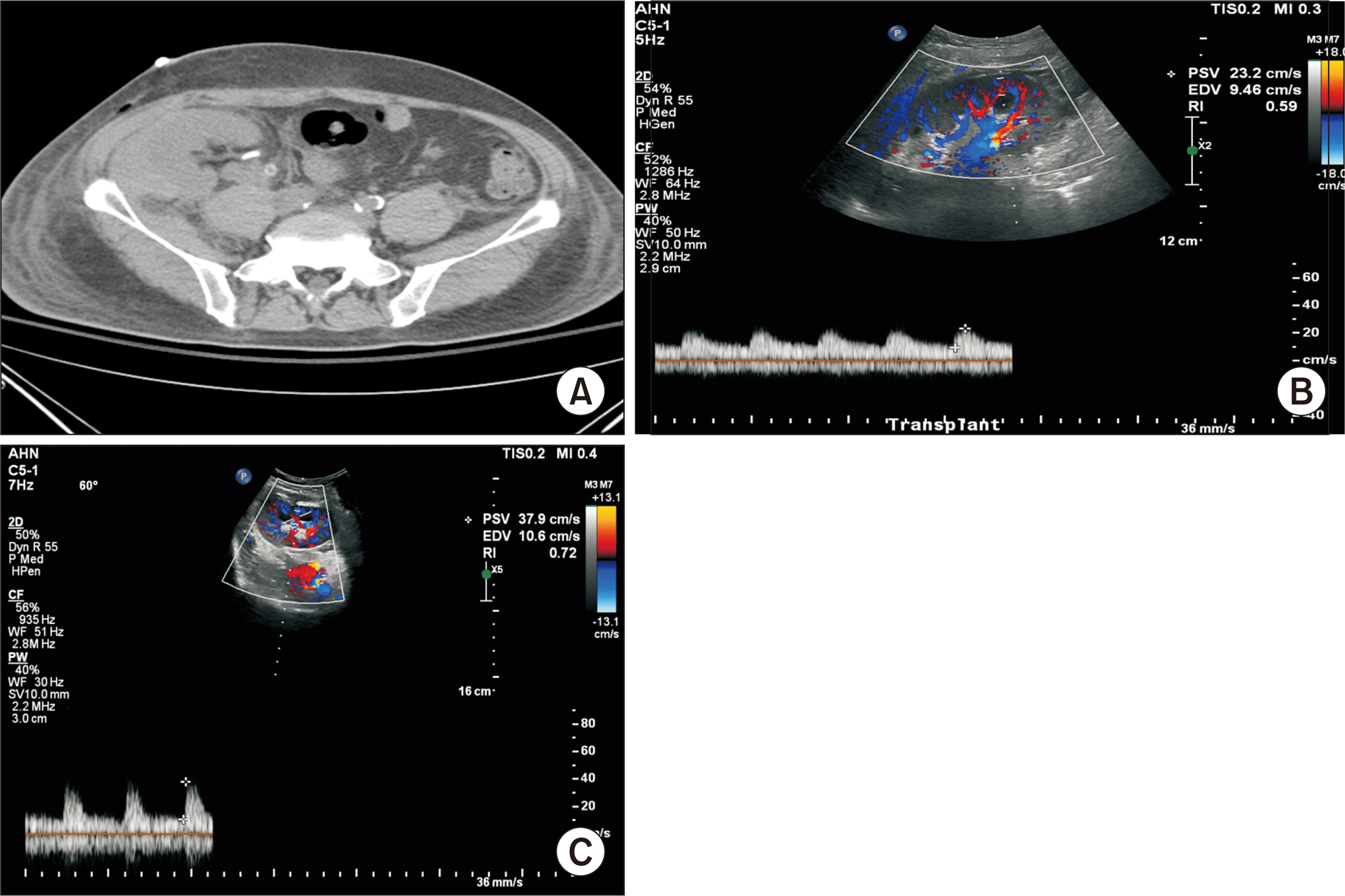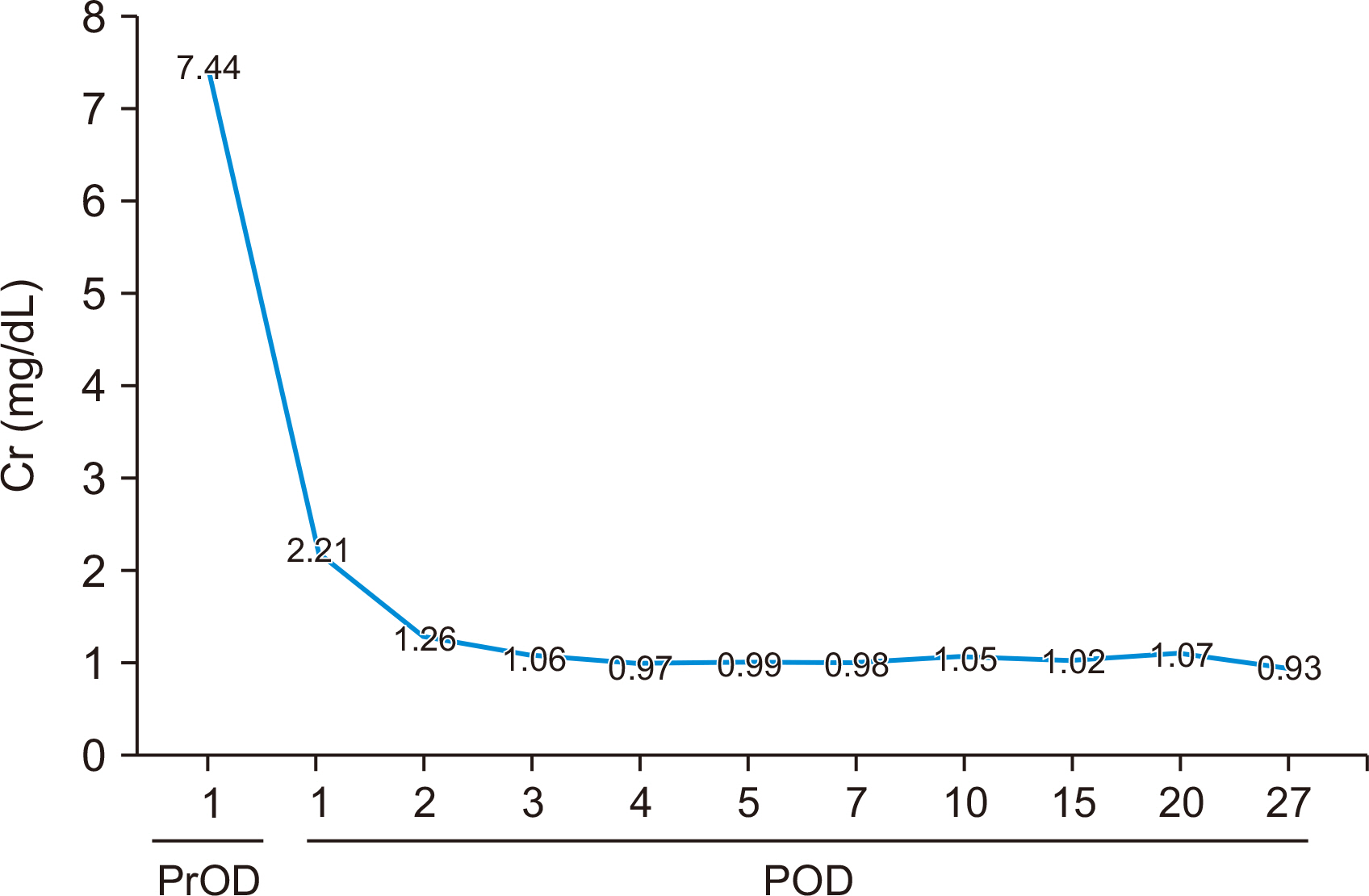Korean J Transplant.
2022 Mar;36(1):67-72. 10.4285/kjt.21.0027.
The use of polytetrafluoroethylene graft for damaged renal artery in ABO-incompatible living donor kidney transplantation: a case report
- Affiliations
-
- 1Department of Surgery, Jeju National University Hospital, Jeju National University College of Medicine, Jeju, Korea
- 2Department of Surgery, Seoul National University Bundang Hospital, Seoul National University College of Medicine, Seongnam, Korea
- KMID: 2527900
- DOI: http://doi.org/10.4285/kjt.21.0027
Abstract
- Short donor renal vessels during donor nephrectomy represent a technical challenge. The allograft of vessels from deceased donors can be an option for reconstruction; however, cryopreserved vessels are not routinely prepared for living donor kidney transplantation (LDKT). We report a reconstruction of the damaged short renal artery (RA) in LDKT using a polytetrafluoroethylene (PTFE) graft. A 45-year-old male patient underwent ABO-incompatible LDKT from his wife. After donor nephrectomy, we detected a hematoma surrounding the proximal RA of the allograft. The injured segment of the RA was transected, and the short RA was connected to the right external artery of the recipient; however, the blood flow was interrupted by the graft location. Once the arterial anastomosis was removed, the graft was flushed with cold saline, and a PTFE graft was used for the reconstruction of the short RA. Immediate blood flow to the renal graft was excellent without sign of parenchymal infarction until fascial closure. Renal graft Doppler on postoperative day 7 and 3 months showed good blood flow. In this patient, the use of PTFE graft presented no additional morbidity to the kidney transplantation, and no postoperative complications related to its use were noted.
Figure
Reference
-
1. Hernández D, Alonso-Titos J, Armas-Padrón AM, Ruiz-Esteban P, Cabello M, López V, et al. 2018; Mortality in elderly waiting-list patients versu age-matched kidney transplant recipients: where is the risk? Kidney Blood Pres Res. 43:256–75. DOI: 10.1159/000487684. PMID: 29490298.2. Ruggenenti P, Silvestre C, Boschiero L, Rota G, Furian L, Perna A, et al. 2017; Long-term outcome of renal transplantation from octogenarian donors: a multicenter controlled study. Am J Transplant. 17:3159–71. DOI: 10.1111/ajt.14459. PMID: 28792681.
Article3. Lee S, Kim J, Shin M, Kim E, Moon J, Jung G, et al. 2010; Comparison of outcomes of living and deceased donor kidney grafts surviving longer than 5 years in Korea. Transplant Proc. 42:775–7. DOI: 10.1016/j.transproceed.2010.02.032. PMID: 20430168.
Article4. Ghazanfar A, Tavakoli A, Zaki MR, Pararajasingam R, Campbell T, Parrott NR, et al. 2010; The outcomes of living donor renal transplants with multiple renal arteries: a large cohort study with a mean follow-up period of 10 years. Transplant Proc. 42:1654–8. DOI: 10.1016/j.transproceed.2009.12.067. PMID: 20620494.
Article5. De Rosa P, Santangelo M, Ferrara A, Pelosio L, Vallefuoco DM, Caggiano L, et al. 2004; Suboptimal kidney: the experience of a single transplant unit. Transplant Proc. 36:488–90. DOI: 10.1016/j.transproceed.2004.02.008. PMID: 15110566.
Article6. Davari HR, Malek-Hossini SA, Salahi H, Bahador A, Rais-Jalali GA, Behzadi S, et al. 2003; Sequential anastomosis of accessory renal artery to external iliac artery in the management of renal transplantation with multiple arteries. Transplant Proc. 35:329–31. DOI: 10.1016/S0041-1345(02)03838-1. PMID: 12591426.
Article7. Vicéns-Morton AJ, Callaghan C, Olsburgh J. 2017; Reconstruction of a damaged lower polar artery for kidney transplantation using tubularised donor aorta. Case Rep Transplant. 2017:3532473. DOI: 10.1155/2017/3532473. PMID: 29123936. PMCID: PMC5662833.
Article8. Kamel MH, Thomas AA, Mohan P, Hickey DP. 2007; Renal vessel reconstruction in kidney transplantation using a polytetrafluoroethylene (PTFE) vascular graft. Nephrol Dial Transplant. 22:1030–2. DOI: 10.1093/ndt/gfl782. PMID: 17210600.
Article9. McLoughlin LC, Davis NF, Dowling CM, Power RE, Mohan P, Hickey DP, et al. 2014; Ex vivo reconstruction of the donor renal artery in renal transplantation: a case-control study. Transpl Int. 27:458–66. DOI: 10.1111/tri.12281. PMID: 24851246.
Article10. Nguefouet Momo RE, Donato P, Ugolini G, Nacchia F, Mezzetto L, Veraldi GF, et al. 2020; Kidney transplantation from living donor with monolateral renal artery fibromuscular dysplasia using a cryopreserved iliac graft for arterial reconstruction: a case report and review of the literature. BMC Nephrol. 21:451. DOI: 10.1186/s12882-020-02097-w. PMID: 33115426. PMCID: PMC7594424.
Article11. Lavigne J, Keppenne V, Limet R. 1999; Late rupture of a saphenous vein aortorenal graft. J Vasc Surg. 29:722–3. DOI: 10.1016/S0741-5214(99)70321-6. PMID: 10194503.
Article12. Dean RH, Wilson JP, Burko H, Foster JH. 1974; Saphenous vein aortorenal bypass grafts: serial arteriographic study. Ann Surg. 180:469–78. DOI: 10.1097/00000658-197410000-00012. PMID: 4415681. PMCID: PMC1344125.13. Travis JA, Hansen KJ, Miller PR, Dean RH, Geary RL. 2000; Aneurysmal degeneration and late rupture of an aortorenal vein graft: case report, review of the literature, and implications for conduit selection. J Vasc Surg. 32:612–5. DOI: 10.1067/mva.2000.108639. PMID: 10957672.
Article14. Levy MM, Kiang W, Johnson JM, Myers SI. 2008; Saphenous vein graft aneurysm with graft-enteric fistula after renal artery bypass. J Vasc Surg. 48:738–40. DOI: 10.1016/j.jvs.2008.03.045. PMID: 18727972.
Article15. Tomizawa M, Hori S, Nishimura N, Omori C, Nakai Y, Miyake M, et al. 2020; Arterial reconstruction using the donor's gonadal vein in living renal transplantation with multiple renal arteries: a case report and a literature review. BMC Nephrol. 21:190. DOI: 10.1186/s12882-020-01848-z. PMID: 32434562. PMCID: PMC7238598.
Article16. Blacklock AR, Raabe AL, Lam FT. 1999; Renal auto-transplantation with interposed PTFE arterial graft: not necessarily a cure for loin pain/haematuria syndrome. J R Coll Surg Edinb. 44:134. PMID: 10612970.17. Delpín ES. 1997; Brief report: successful extension of the transplant renal vein with a synthetic vascular graft. Bol Asoc Med P R. 89:206–7. PMID: 9577058.18. Prager MR, Hoblaj T, Nanobashvili J, Sporn E, Polterauer P, Wagner O, et al. 2003; Collagen- versus gelatine-coated Dacron versus stretch PTFE bifurcation grafts for aortoiliac occlusive disease: long-term results of a prospective, randomized multicenter trial. Surgery. 134:80–5. DOI: 10.1067/msy.2003.179. PMID: 12874586.
Article19. Naoum JJ, Arbid EJ. 2012; Bypass surgery in limb salvage: polytetrafluoroethylene prosthetic bypass. Methodist Debakey Cardiovasc J. 8:43–6. DOI: 10.14797/mdcj-8-4-43. PMID: 23342188. PMCID: PMC3549650.
Article
- Full Text Links
- Actions
-
Cited
- CITED
-
- Close
- Share
- Similar articles
-
- Analysis of the Results of ABO-Incompatible Kidney Transplantation: In Comparison with ABO-Compatible Kidney Transplantation
- ABO-Incompatible Kidney Transplantation
- Successful renal artery reconstruction using a polytetrafluoroethylene graft in living donor kidney transplantation: a case report
- Successful Pediatric ABO-Incompatible Kidney Transplantation without Pretransplant Plasmapheresis: Report of a Case
- ABO-Incompatible Living Donor Liver Transplantation

